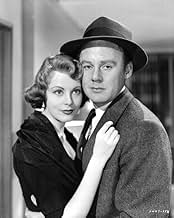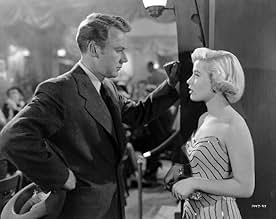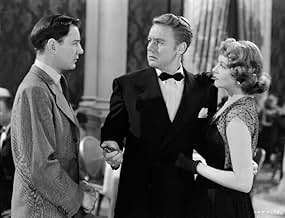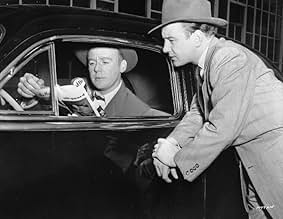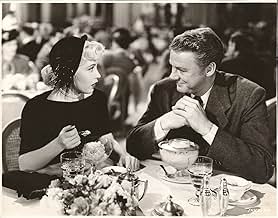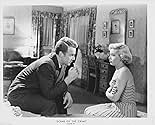IMDb रेटिंग
6.6/10
1.6 हज़ार
आपकी रेटिंग
अपनी भाषा में प्लॉट जोड़ेंWhile his wife is urging him to quit the force, a Los Angeles homicide detective hunts for the killer responsible for the murder of his ex-partner, who might have been on the take with local... सभी पढ़ेंWhile his wife is urging him to quit the force, a Los Angeles homicide detective hunts for the killer responsible for the murder of his ex-partner, who might have been on the take with local bookies.While his wife is urging him to quit the force, a Los Angeles homicide detective hunts for the killer responsible for the murder of his ex-partner, who might have been on the take with local bookies.
- पुरस्कार
- कुल 1 नामांकन
Gloria DeHaven
- Lili
- (as Gloria De Haven)
Bette Arlen
- Girl with Sleeper
- (बिना क्रेडिट के)
फ़ीचर्ड समीक्षाएं
They're all here. Lovelorn wife, old cop trying to stick around, gangsters with neat nicknames, forensic lab work, stool pigeons, etc. There is also an uninteresting back story about a job the wife is trying to get for her husband-cop, to "keep him safe". Think of a familiar plot device and it's here in "Scene Of The Crime".
That said, this picture holds your interest - it's a good story, when all is said and done. Good acting from start to finish and there are lots of good character actors; John McIntyre, Norman Lloyd, Gloria DeHaven, Jerome Cowan, and many others. I disagree with a reviewer above in that the picture held my interest right to the end, although I am a big fan of noir films. I did think that Van Johnson was a curious choice for the title role. I always thought there wasn't a mean bone in his body, not tough enough to play a detective in a gritty noir.
Lastly, the music director was Andre Previn, and the theme music at the beginning and end was good. He also wrote two songs that were unworthy of him, but they were played in a strip joint and fit into the setting with their trite tunes and lyrics. Despite all of the preceding, I rated it a seven, which means I think it's worth your time.
That said, this picture holds your interest - it's a good story, when all is said and done. Good acting from start to finish and there are lots of good character actors; John McIntyre, Norman Lloyd, Gloria DeHaven, Jerome Cowan, and many others. I disagree with a reviewer above in that the picture held my interest right to the end, although I am a big fan of noir films. I did think that Van Johnson was a curious choice for the title role. I always thought there wasn't a mean bone in his body, not tough enough to play a detective in a gritty noir.
Lastly, the music director was Andre Previn, and the theme music at the beginning and end was good. He also wrote two songs that were unworthy of him, but they were played in a strip joint and fit into the setting with their trite tunes and lyrics. Despite all of the preceding, I rated it a seven, which means I think it's worth your time.
Two veteran Los Angeles police detectives and a well-meaning rookie set out to find the killer of an off-duty fellow officer who may have been on the take. This is an L.A. filled with dangerous broads, bookie joints, ex-bootleggers in on a new racket, and cops in natty suits and broad-billed hats. The pulpy, slangy dialogue is fun at times, as are the performances from Van Johnson and Gloria DeHaven (playing a chanteuse "with a figure like champagne and a heart like the cork"). Other, later crime-dramas would quickly up the ante on such a scenario, but this one is a fine example of the compact policer. M-G-M was downsizing their budgets at the time and trying their hand at different types of films--which provided the perfect opportunity for matinée idols like Johnson to stretch their acting muscles. The results here are not exactly noir, but more from an overtly-ordinary, overtly-jaded mold, with everyday people going about their business and getting the job done. If it isn't exciting, at least it's highly competent. **1/2 from ****
This is a very entertaining look at big city cops and robbers with shades of film noir showing though. The standout performance in a potentially femme fatale role is Gloria DeHaven. I suspect the writers, John Bartlow Martin and Charles Schnee, along with director Roy Rowland, had experiences with untrustworthy women, for Lili (Gloria DeHaven) could turn any man's heart to putty, then fool him over and over. Van Johnson too turns in a subdued performance which is called for in the character (Mike Conovan) he plays. Conovan's very liberal wife, especially for 1949, is played by Arlene Dahl, who is fed up with the demands of her husband's job but who also trusts her husband to be with a vixen and still stay true to her. This is an effective counterbalance to the untrustworthiness of Lili. Great supporting roles abound filled with standout performances from John McIntire's "too old to cut the mustard" part all the way to the Sleeper, Norman Lloyd. Yuk, Yuk, it's great. There is a lot of realistic blood and guts thrown in complete with car chases that foretell things to come in action movies. Heat up some popcorn, get a cold one, then sit back and enjoy the ride.
I guess the lesson here is that you can take the crime drama out of MGM, but you can't take MGM out of the crime drama. With noirish location shots, the new Dore Schary regime changed the usual MGM look somewhat, yet the movie still boasts a string of stars and star power for which the studio was known. The trouble is that working Van Johnson, Arlene Dahl, Tom Drake, Gloria DeHaven, Donald Woods, and a string of "name" supporting players into the screenplay with sufficient screen time for each overstretches the results. Despite some effective moments (the hotel room fistfight, the fright screams from the burning car), the movie suffers from too much flab for overall effect. For example, the two rather lengthy scenes with Norrie Lorfield (Tom Helmore), the rival for Conovan's (Johnson) wife, are simply a needless distraction from the main plot, and work to dilute the overall effect. In fact, the entire marital subplot should have been dropped or at least minimized, but it seems that the studio was not satisfied with the kind of fast, efficient little crime drama that RKO, for one, routinely turned out.
I'm tempted to say that just as movie spectaculars and historical epics depend on big budgets for optimal effect, crime dramas and noirs depend on the tight disciplining constraints of small ones. That way, production values don't interfere with the story line. Here it appears that MGM's celebrated production values over-produced the number of feature players, which, in turn, multiplied the various subplots, or vice-versa. In either case, it's too bad the script didn't eliminate a few of these in favor of giving Norman Lloyd's truly memorable character, Sleeper, more screen time. He's the kind of unique character that could have transformed this otherwise forgettable exercise into a memorable one.
I'm tempted to say that just as movie spectaculars and historical epics depend on big budgets for optimal effect, crime dramas and noirs depend on the tight disciplining constraints of small ones. That way, production values don't interfere with the story line. Here it appears that MGM's celebrated production values over-produced the number of feature players, which, in turn, multiplied the various subplots, or vice-versa. In either case, it's too bad the script didn't eliminate a few of these in favor of giving Norman Lloyd's truly memorable character, Sleeper, more screen time. He's the kind of unique character that could have transformed this otherwise forgettable exercise into a memorable one.
An off-duty Los Angeles police detective is shot and killed one night with an unexplained thousand dollars found in his pocket. It falls to his former partner (Van Johnson) to track down his killers and try to exonerate him. Scene of the Crime, which tells the story, stays a police procedural with a few twists and touches that raise it a notch or two above the routine.
First of all, Johnson's wife (Arlene Dahl) has fallen prey to the dissatisfactions common to her lot. She's tired of their evenings, in and out, being ruined by yet another summons to duty (`Whenever the telephone rings, it cuts me,' she cries); she tired of rolling his dice rigged to come up seven, a ritual that supposedly bids him luck.
On the job, he has his burdens, too. His new partner (John McIntyre) is getting on in years and his sight is failing. And under Johnson's wing is nestled rookie cop Tom Drake, learning the ropes. Outside the office there's an abrasive police reporter (Donald Woods) chasing the corruption angle; there's also the network of low-lifes who serve, if the pressure is right, as stoolies - most vivid of them is the young Norman Lloyd.
Word filters up that the killing was the work of a couple of downstate `lobos' who have been knocking over bookie operations. Going undercover, Johnson starts romancing a stripper one of them used to date (Gloria De Haven, in the movie's sharpest performance). Even though he's working her, he finds his emotions in play - and even though it turns out that she's working him, too, she has no emotions.
Under Roy Rowland's direction, Scene of the Crime keeps its plotting straightforward, though with some uncharacteristic bursts of violence. The movie's studio, Metro-Goldwyn-Mayer, was celebrated for its lavish color musicals, not for the unsentimental style of film noir. That probably accounts for the final shot's being a reconciliatory kiss, in hopes that such a sweet image might expunge all the urban squalor that went before it. Luckily, it doesn't.
First of all, Johnson's wife (Arlene Dahl) has fallen prey to the dissatisfactions common to her lot. She's tired of their evenings, in and out, being ruined by yet another summons to duty (`Whenever the telephone rings, it cuts me,' she cries); she tired of rolling his dice rigged to come up seven, a ritual that supposedly bids him luck.
On the job, he has his burdens, too. His new partner (John McIntyre) is getting on in years and his sight is failing. And under Johnson's wing is nestled rookie cop Tom Drake, learning the ropes. Outside the office there's an abrasive police reporter (Donald Woods) chasing the corruption angle; there's also the network of low-lifes who serve, if the pressure is right, as stoolies - most vivid of them is the young Norman Lloyd.
Word filters up that the killing was the work of a couple of downstate `lobos' who have been knocking over bookie operations. Going undercover, Johnson starts romancing a stripper one of them used to date (Gloria De Haven, in the movie's sharpest performance). Even though he's working her, he finds his emotions in play - and even though it turns out that she's working him, too, she has no emotions.
Under Roy Rowland's direction, Scene of the Crime keeps its plotting straightforward, though with some uncharacteristic bursts of violence. The movie's studio, Metro-Goldwyn-Mayer, was celebrated for its lavish color musicals, not for the unsentimental style of film noir. That probably accounts for the final shot's being a reconciliatory kiss, in hopes that such a sweet image might expunge all the urban squalor that went before it. Luckily, it doesn't.
क्या आपको पता है
- ट्रिवियाThis film has many actors cast against previous types. Van Johnson had appeared in light comedies and musicals, making him a teen idol at the time. His versatility, proven in this film, would lead to his role in Battleground (1949). Gloria DeHaven has previously been cast as sweet, innocent girls, but here she is a stripper and gun moll. Gorgeous Arlene Dahl, formerly a high-paid covergirl before marrying Mike, spurns the glamorous life and tries hard to accept the role the stay-at-home wife of a cop (whom she is desperately in love with, and daily fears losing).
- गूफ़When Detective Piper introduces the young man that sold the .38 S&W revolver to the cop killer to detective Conovan the man says he sold the gun to a man in a bar. Conovan then assails the man over his getting a lousy eighty bucks for the gun that killed his former partner - lousy in what became of the gun, not the price, easily twice what the gun was worth. But at no time did the man or Piper mention getting that amount for the gun. It appears Piper had already reported in by phone, perhaps via CC, as Conovan did not register the least surprise at him appearing at the headquarters with the former gun owner in tow. And Conovan acted as though he already was familiar with the gist of the pickup, and was on edge and ready to talk hostilely to the young man, even threaten unlawful activities toward him.
- भाव
Sleeper: Naturally, I know you know I know somethin'.
Mike Conovan: I know you know I know you know somethin'.
- कनेक्शनFeatured in Some of the Best: Twenty-Five Years of Motion Picture Leadership (1949)
- साउंडट्रैकI'M A GOODY-GOODY GIRL
(uncredited)
Music by André Previn
Lyrics by William Katz
Sung (with partial striptease) by Jean Carter
टॉप पसंद
रेटिंग देने के लिए साइन-इन करें और वैयक्तिकृत सुझावों के लिए वॉचलिस्ट करें
- How long is Scene of the Crime?Alexa द्वारा संचालित
विवरण
- रिलीज़ की तारीख़
- कंट्री ऑफ़ ओरिजिन
- भाषा
- इस रूप में भी जाना जाता है
- La ciudad del crimen
- फ़िल्माने की जगहें
- 259 E. 5th Street, लॉस एंजेल्स, कैलिफोर्निया, संयुक्त राज्य अमेरिका(site of Hippo's Coffee Pot)
- उत्पादन कंपनी
- IMDbPro पर और कंपनी क्रेडिट देखें
बॉक्स ऑफ़िस
- बजट
- $7,61,000(अनुमानित)
- चलने की अवधि1 घंटा 34 मिनट
- रंग
- पक्ष अनुपात
- 1.37 : 1
इस पेज में योगदान दें
किसी बदलाव का सुझाव दें या अनुपलब्ध कॉन्टेंट जोड़ें




